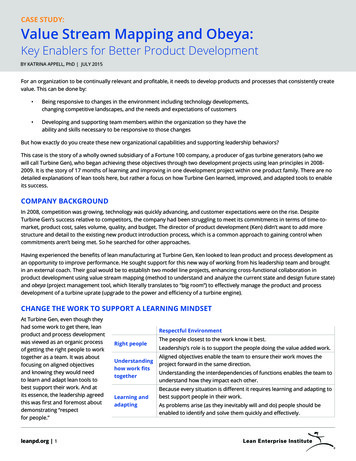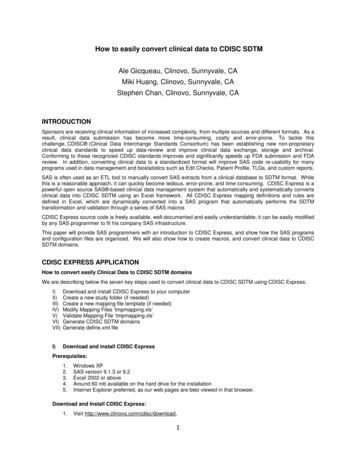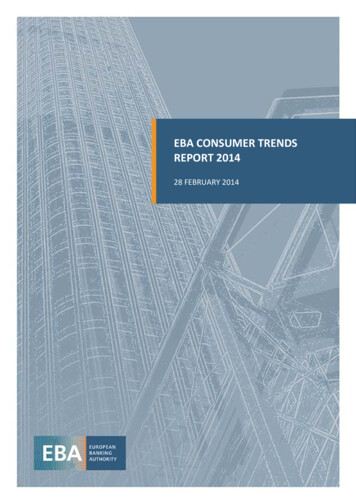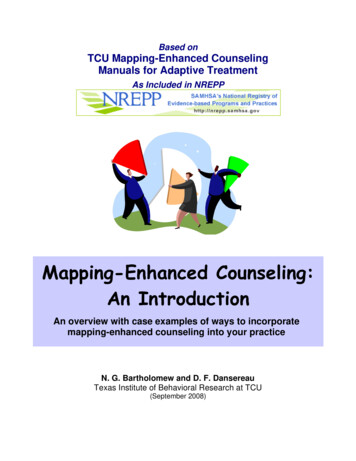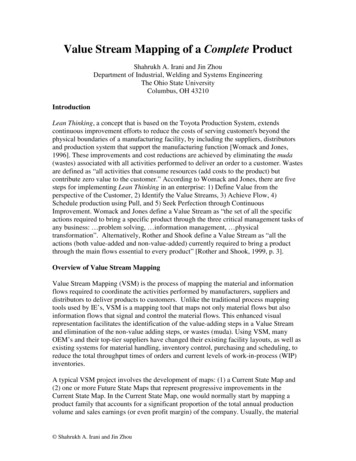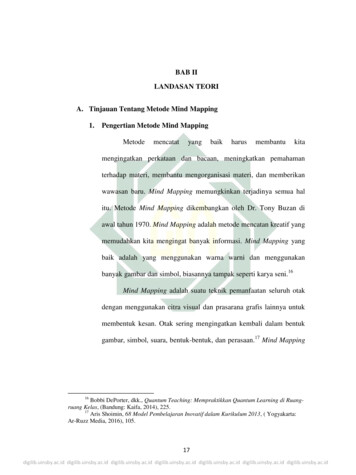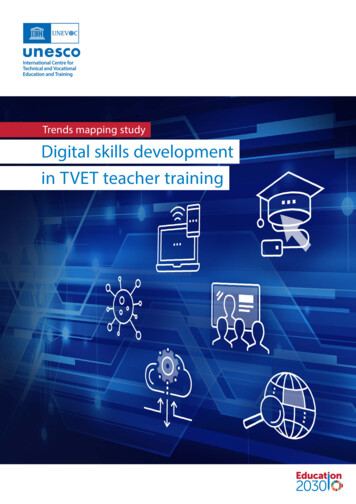
Transcription
Trends mapping studyDigital skills developmentin TVET teacher training
Trends mapping studyDigital skills developmentin TVET teacher training
UNESCO – a global leader in educationEducation is UNESCO’s top priority because it is abasic human right and the foundation for peaceand sustainable development. UNESCO is theUnited Nations’ specialized agency for education,providing global and regional leadership to driveprogress, strengthening the resilience and capacityof national systems to serve all learners. UNESCOalso leads efforts to respond to contemporaryglobal challenges through transformative learning,with special focus on gender equality and Africaacross all actions.The Global Education 2030 AgendaUNESCO, as the United Nations’ specialized agency foreducation, is entrusted to lead and coordinate theEducation 2030 Agenda, which is part of a globalmovement to eradicate poverty through 17 SustainableDevelopment Goals by 2030. Education, essential toachieve all of these goals, has its own dedicated Goal 4,which aims to “ensure inclusive and equitable qualityeducation and promote lifelong learning opportunitiesfor all.” The Education 2030 Framework for Actionprovides guidance for the implementation of thisambitious goal and commitments.UNESCO-UNEVOC InternationalCentre for Technical and VocationalEducation and TrainingUN CampusPlatz der Vereinten Nationen 153113 BonnGermanyThe designations employed and the presentation ofmaterial throughout this document do not imply theexpression of any opinion whatsoever on the part ofUNESCO concerning the legal status of any country,territory, city or area or of its authorities, or concerningthe delimitation of its frontiers or boundaries. UNESCO 2022The ideas and opinions expressed in this documentare those of the authors; they are not necessarily thoseof UNESCO and do not commit the Organization.Written by Gita SubrahmanyamThis publication is available in Open Access under theAttribution-ShareAlike 3.0 IGO (CC-BY-SA 3.0 IGO)license ). By using the content of this publication,the users accept to be bound by the terms of use ofthe UNESCO Open Access Repository (http://www.unesco.org/open-access/terms-use- ccbysa-en).Supervised by Sarah Elson-Rogers, UNESCO-UNEVOCInternational Centre for TVETDesign by Ulrike KöhnCover image: .com
AcknowledgementsThis report was prepared by Gita Subrahmanyam, Research Associate at the London School of Economics,supervised by and with input from Sarah Elson-Rogers, Team Leader of the Innovation and the Future of TVETProgramme at UNESCO-UNEVOC. The study was initiated by Jens Liebe (previously at UNESCO-UNEVOC).Special thanks to those who contributed to the promising practice case studies – namely, Vikki Liogier (NationalHead of EdTech and Digital Skills of the UK Education and Training Foundation), Navitri Putri Guillaume (ProjectOfficer for the ILO Field Office in Indonesia’s Women in STEM Workforce Readiness and Development Programme),Pichpisey Sovann (Co-founder of Velocity Arcademy) and Frederic Murat (Head of International Operations atBibliothèques Sans Frontières) – for generously giving their time and sharing their experiences and insights.
ContentsList of tables and figures . 6Abbreviations . 7Introduction . 8Background and context . 8Purpose of study . 8Analytical framework and methodology . 8Structure of this report . 10Pre-pandemic situation . 11Access to training . 12Uptake of training . 17Capacity to apply digital skills . 19Propensity to apply digital skills . 21Summary of pre-pandemic trends and challenges . 25Pandemic response . 26Access to training . 28Propensity to develop and apply digital skills . 31Partnerships for advancing digitalization . 34Tackling digitalization challenges: promising concepts and practices . 35Promising concepts . 35Promising practices . 39Conclusion and recommendations . 47References . 51Trends mapping study: Digital skills development in TVET teacher training5
List of tablesTable 1. Analytical framework for trends mapping study of digital skills development in TVET teacher training. 10Table 2. Percentage of public schools with electricity, computers and internet used for pedagogical purposesin 2018. 13Table 3. Four-stage model of ICT adoption in TVET. 19Table 4. Overview and indicators related to the four stages of ICT adoption in TVET. 20Table 5. Summary of trends and challenges in TVET teacher digital skills development. 49List of figuresFigure 1. Percentage of students with internet connection at home in 2019. 13Figure 2. Use of online and/or other forms of distance learning by TVET providers before the outbreak,by region. 15Figure 3. Proportion of OECD upper secondary VET teachers integrating digital technologiesin their teaching. 22Figure 4. Relationships between lack of teacher/trainer confidence and other barriersto technology adoption. 24Figure 5. Closure of TVET centres, by region, during the early COVID-19 pandemic period. 27Figure 6. Mode of TVET training during early COVID-19 pandemic period, by national income level. 27Figure 7. Additional resources committed for the use of distance learning by TVET providers. 28Figure 8. Use of new tools and resources during the early COVID-19 pandemic period, by income group. 29Figure 9. Training and support provided to TVET teaching staff at national level (% of OECD countries). 30Figure 10. Fixed broadband prices as a percentage of monthly GNI per capita, 2019-2020. 32Figure 11. Data-only mobile broadband prices as a percentage of monthly GNI per capita, 2019-2020. 33Figure 12. ETF’s Digital Teaching Professional Framework (DTPF). 40Trends mapping study: Digital skills development in TVET teacher training6
AbbreviationsBSFBibliothèques Sans FrontièresCEDEFOPEuropean Centre for theDevelopment of VocationalTrainingCPDContinuous professionaldevelopmentDigCompEduEuropean Framework for theDigital Competence of EducatorsODLOpen and distance learningOECDOrganisation for EconomicCo-operation and DevelopmentOEROpen educational resourceSELFIESelf-reflection on Effective Learningby Fostering the Use of InnovativeEducational technologies tool(European Commission)DTPFDigital Teaching ProfessionalFrameworkSTEMScience, technology, engineeringand/or mathematicsEdTechTALISOECD Teaching and LearningInternational SurveyEducational technologiesETFEducation and TrainingFoundation (UK)ICTInformation and communicationtechnologiesILOInternational Labour OrganizationITUInternational TelecommunicationUnionTVETTechnical and vocational educationand trainingUISUNESCO Institute for StatisticsUNESCOUnited Nations Educational,Scientific and Cultural OrganizationLMSLearning Management SystemUNEVOCUNESCO International Centre forTechnical and Vocational Educationand TrainingMOOCMassive open online courseVETVocational education and trainingNGONon-governmental organizationWBWorld BankTrends mapping study: Digital skills development in TVET teacher training7
IntroductionBackground and contextDigitalization has led to extensive changes in the skillsrequired for work and life. For technical and vocationaleducation and training (TVET) institutions to remainrelevant and attractive, they need to identify andintroduce digital skills and competencies for the changingworld of work, and to better utilize the opportunitiesprovided by digitalization, particularly distance learning.Their success in harnessing the benefits and tackling thechallenges of digitalization largely depends on the digitalcapabilities of TVET teachers and trainers.Teachers and trainers face multiple challenges to keepup with the latest digital transformations and toupgrade their skills to apply modern technology-aidedinstruction. Likewise, managers of TVET institutions arehindered by the lack of support in creating enablingdigital environments and building innovative institutions.The COVID-19 pandemic has revealed countries’ differentlevels of preparedness in terms of distance learning andtheir varying abilities to address this challenge effectively.Purpose of studyThe purpose of this study is to map trends andchallenges in the training of TVET teachers andtrainers in the context of digitalization, and to identifyexamples of innovative TVET teacher training effortsthat have proven successful. The study builds on therecently published UNESCO-UNEVOC Study on theTrends Shaping the Future of TVET Teaching (UNESCOUNEVOC, 2020a) and complements its enquiry on thedigital skills required by TVET teachers and trainers tofulfil their role in preparing learners for the future ofwork and of learning.The study provides a snapshot of trends and challengesin TVET teacher and trainer digital skills development.Its findings – in terms of data, policy trends and theidentification of good practice examples concerningTVET teacher training – will inform UNESCO-UNEVOC’swork in support of TVET teachers and trainers.Analytical framework and methodologyTo gain a better understanding of latest trends indigital skills development in TVET teacher training,this study explores its status both before and duringthe COVID-19 pandemic. It examines how differentcountries have responded to the need to move toremote learning environments. It also considers howcountries have supported TVET teachers and trainersto develop the skills and competencies needed to usedigital tools, services and technologies to deliverquality, learner-centred education and training, inparticular practice-oriented learning, which is thehallmark of quality TVET provision.This study uses an analytical framework that separatesout the two key aspects of digitalization for TVETteachers and trainers, namely:(a) the use of digital tools and services forteaching TVET; and(b) the digital delivery of TVET through distancelearning.The first dimension refers to the integration of digitaltools and technology in teaching TVET. This includes,for example, using augmented reality technology toconstruct virtual 3D models and allowing learners tointeract with state-of-the-art tools and equipmentused in the workplace and to practise executingcomplex tasks in a controlled environment. Thesecond dimension refers to the use of digital tools anddigital content to deliver TVET at a distance. Thisincludes, for example, using videoconferencing tools(such as Zoom) to communicate with students oronline learning platforms (such as Moodle) to sharelearning resources and monitor student performance.Each dimension requires differentiated support forTVET teachers/trainers. The UNESCO-UNEVOC study(2020a) makes clear that preparing teaching staff tomake effective use of digital tools and services forteaching TVET involves:(a)building TVET teachers’/trainers’ digital skills,as well as their knowledge of new digitaltechnologies, equipment and/or practices inthe workplace; and(b)developing teachers’/trainers’ skills andcompetencies in applying new pedagogicalapproaches, instructional tools and/oreducational technologies to deliver learnercentred teaching and training which buildslearners’ digital competencies and future-oriented skills.Trends mapping study: Digital skills development in TVET teacher training8
Preparing TVET teachers/trainers to competentlyuse digital tools, technologies and resources todeliver effective online or offline distance learningrequires:(a) training TVET teachers/trainers to use digitalcommunication tools and online learningplatforms; and(b)developing teachers’/trainers’ skills andcompetencies to apply these tools, technologiesand resources in a pedagogically effectivemanner. Effective online education entails morethan simple online content delivery.High-quality e-learning is flexible, interactive,inclusive and student-centred (Hodges et al.,2020). Furthermore, the knowledge, skills andcompetencies required by TVET teachers/trainers to teach in technology-mediatedenvironments differ from those required forface-to-face teaching, especially when the modeof delivery is asynchronous rather thansynchronous (Barbour, 2012).The two dimensions of digitalization are not mutuallyexclusive. For instance, teachers/trainers delivering fullyonline modules may decide to integrate educationaltechnologies to teach specific concepts or skills.However, separating out the two aspects for analysisprovides sharper insight into issues in TVET teacherprofessional development, particularly in the light ofadjustments made during the COVID-19 pandemic.TVET teacher training does not exist in a vacuum, andintroducing digital technologies into TVET cannotbe an end goal in itself. To maximize returns oninvestment in digital tools and technologies, a clearvision of educational goals, with well-developed andwell-resourced policies and strategies for achievingthem, is needed (Kleiman, 2000). This requires movingbeyond quantitative objectives, such as student/computer ratios, and instead basing technology andtraining decisions on how well they supporteducational goals.To ensure technology is used effectively, or indeedused at all, teachers need not only training on how toapply it to motivate students and improve theiracquisition of knowledge and skills, but also time tointegrate it into their teaching practices. Technicalsupport is also required to quickly overcome issuesthat interfere with teachers’ ability to seamlesslyintegrate digital tools and technologies into teachingand learning processes.The analytical framework applied in this study isshown in Table 1. Exploring trends across the eightcells allows for an assessment of global progressmade and challenges that remain in advancingdigitalization in TVET teacher training, both beforeand during the COVID-19 pandemic. This will be thefocus of Sections 2 and 3 of this report.Trends mapping study: Digital skills development in TVET teacher training9
Support for TVET teachers/trainersUse of digital toolsand services forteaching TVETMeasures to develop TVET teachers’/trainers’basic and advanced digital skills, as well astheir knowledge of new digital technologies,equipment and/or practices in the workplace.Measures to build TVET teachers’/trainers’ skillsand competencies in applying newpedagogical approaches, instructional toolsand/or educational technologies to deliverlearner-centred, future-oriented teaching andtraining.Digital delivery ofTVET throughdistance learningMeasures to develop TVET teachers’/trainers’skills in using digital communication tools andonline learning platforms to deliver online oroffline distance learning.BeforepandemicSincepandemicSection 3 findingsAspects ofdigitalizationSection 2 findingsTable 1. Analytical framework for trends mapping study of digital skills developmentin TVET teacher trainingMeasures to build TVET teachers’/trainers’ skillsand competencies to employ pedagogicallyeffective distance/e-learning methods.The main method of collecting data and informationfor this study was desk research (literature review anddocumentary analysis) to identify trends, challengesand practices across different regions and countrycontexts. The study focuses on the digital skillstraining received by teachers/trainers in formal publicand private TVET institutions, while acknowledgingthat the training received by TVET teachers/trainersoperating in non-formal or informal contexts maydiffer.Interviews were held with selected TVET teachertraining institutions that had been identified throughthe desk research as having innovative or impactfulpractices. The aim was to gain a deeperunderstanding of how TVET teacher traininginstitutions have responded to the opportunitiespresented by digitalization and to collect furtherinformation on innovative TVET teacher trainingefforts that have proven successful in tacklingdigitalization challenges.Structure of this reportThe study’s findings are presented in four sections. Sections 2 and 3 examine global progressmade and challenges that remain in advancingdigitalization in TVET teacher training before(Section 2) and since (Section 3) the COVID-19pandemic. Section 4 provides details of several promisingconcepts and practices that may helpcountries to overcome some of the challengespreventing them from advancing digitalizationin TVET through TVET teacher and trainertraining. The final section summarizes the findings ofthe previous three sections and proposesfuture actions that TVET stakeholders shouldconsider implementing to harness thebenefits of digitalization and meet theemerging expectations of TVET in a rapidlychanging digital world.Trends mapping study: Digital skills development in TVET teacher training10
Pre-pandemic situationEvidence for this section is primarily drawn from surveys undertaken by UNESCO-UNEVOC,the Organisation for Economic Co-operation and Development (OECD), the EuropeanCommission and the International Labour Organisation (ILO) (in cooperation with UNESCOand the World Bank), which pre-date the pandemic and cover both aspects of digitalization.These surveys were chosen for their proximity in time to the pandemic, their global orregional coverage, and their multi-TVET-stakeholder dimensions.Main data sources for this sectionSURVEYS:1. UNESCO-UNEVOC Study on the Trends Shaping the Future of TVET Teaching, which collected data from87 respondents (comprising 25 government/national body representatives, 34 TVET institutionalrepresentatives and 28 TVET practitioners) across 56 countries between November 2019 and January2020 (UNESCO-UNEVOC, 2020a). It is one of the few surveys offering global data on TVET teachertraining prior to the pandemic, so is relied upon for this study, despite its small sample size.2. OECD 2018 Teaching and Learning International Survey (TALIS), which gathered data from over260,000 teachers and 15,000 school leaders from 31 OECD countries/economies and 17 non-OECDmember countries in 2018 (OECD, 2021b; OECD, 2019). TALIS provides information on upper secondaryvocational education and training (VET) teachers’ most urgent professional development needs aswell as the main barriers to VET teachers’ professional development.3. European Commission SELFIE (Self-reflection on Effective Learning by Fostering the Use of InnovativeEducational technologies) tool, which gathered data from upper secondary VET teachers in OECDcountries who used the tool between October 2018 and December 2020 (OECD, 2021b).4. ILO-UNESCO-World Bank online survey of 985 TVET providers across 92 countries conducted between3 April and 15 May 2020 (ILO et al., 2021). Unlike the other sources listed in this section, this surveybenefited from 20/20 hindsight that a global pandemic would occur in 2020, so was able to gatherpost hoc data on the status of digitalization in TVET prior to the COVID-19 pandemic.OTHER SOURCES:5. World Report on TVET, which was commissioned by UNESCO in 2015 and provides information on thestatus of and main drivers for digitalization in TVET (Mead Richardson and Herd, 2015).6. Report of the Joint ILO–UNESCO Committee of Experts on the Application of the Recommendationsconcerning Teaching Personnel, which outlines global trends and issues concerning TVET teachereducation programmes (Rawkins, 2018).Trends mapping study: Digital skills development in TVET teacher training11
The following four areas are examined in order todocument pre-pandemic trends and challenges inTVET teacher digital skills development. Access to training: Consideration is given to howfar TVET teaching staff were offered opportunitiesto develop their digital skills through pre-serviceand/or in-service training, and in what cases andfor what reasons such training was not available. Uptake of training: Just because digital skillsdevelopment opportunities are available doesnot mean that TVET teachers/trainers will takethem up. Reasons for not engaging may bespecific to digital skills (e.g. technophobia), orapply generally to all training (e.g. lack of time). Capacity to apply digital skills: Digital skillsdevelopment occurs on a continuum, beginningwith acquisition of digital skills and progressingto the ability to apply digital tools and services inways that enhance teaching and learningprocesses. The coverage and depth of the digitaland pedagogical skills training received by TVETteachers/trainers will determine their capacity toeffectively integrate digital tools and resources inteaching/training in meaningful ways. Propensity to apply digital skills: Beyondthe capacity to apply digital tools and servicesin teaching and training processes, TVET teachers/trainers must also have a propensity to do so. Thiswill be influenced by the presence of institutionalstructures and culture to support, encourage andenable teachers’/trainers’ efforts.dependent on innovations and technology-driven, tofunction effectively without their own trainingsupport framework’ (Axmann et al., 2015).In sub-Saharan Africa, digital skills developmentopportunities were restricted. According to UNESCO(2020b), prior to the pandemic only 50% of secondaryteachers across sub-Saharan Africa had received theminimum required teacher training, which in manycases did not build their digital skills.The reasons for TVET teachers’ and trainers’ lack ofaccess to training in general included the following: Systemic lack of resources. The 2015 UNESCOWorld Report on TVET noted: ‘In Zambia, where thelevel of government subvention to TVET institutionsis very low (less than 6% in some cases) it is costprohibitive for institutions to progress the use of ICT[information and communication technologies]. Thecosts have to be passed on as increased fees tolearners, which then reduces the number of thepopulation who can afford TVET courses’ (MeadRichardson and Herd, 2015, p. 14). A 2015 study onTVET teacher education in Africa found that lack ofresources led to there being limited professionaldevelopment opportunities for TVET teachers,whose skills often became quickly outdated(Grijpstra, 2015). Similar issues were observed whenteacher education programmes were provided byinternational agencies, donor organizations and/ornon-governmental organizations (NGOs): they wereoften not universally available, sustained or wellintegrated into national provision (Rawkins, 2018).Specifically addressing teachers’/trainers’ lack oftraining in digital skills, barriers included:Access to trainingThe most significant differences in access to digitalskills training observed in the available global surveysand literature pre-pandemic pivoted on countries’income levels, including the following points.TVET teachers’/trainers’ access to any kind oftraining, including in digital skills, differed accordingto their countries’ income level.UNESCO-UNEVOC (2020a) survey respondents fromlow- and lower-middle-income countries were morelikely than those in higher-income countries to reportresource constraints (often linked with TVET’s lowstatus), which meant that TVET teachers/trainers hadless access to training opportunities in general. A 2015ILO report noted that in many low- and lower-middleincome countries, ‘pre-service programmes andin-service programmes for teachers and instructors areoften not in place, creating difficulties for personnelworking in a sector such as TVET, which is highly Lack of digital access and infrastructure, such as alack of electricity, computers and/or internet forpedagogical use (see Table 2), and restrictedopportunities for the use of digital tools andtechnologies for teaching, especially in rural areas(Haji et al., 2017). In 2019, 80% of primary andsecondary students in sub-Saharan Africa and 50%in the Asia-Pacific region lacked home internetaccess (see Figure 1). Furthermore, the use oflow-tech digital distance learning approaches toincrease access to and inclusion in TVET was notviable in many low- and lower-middle-incomecountries owing to limited access to communicationdevices. As the Global Education Monitoring Report2020 noted: ‘Among the poorest 20% of households,the share of those who owned a radio was 7% inEthiopia (2016), 8% in the Democratic Republic ofthe Congo (2014), 14% in Madagascar (2016) and30% in Kenya (2014), with none owning a television’(UNESCO, 2020a, p. 60).Trends mapping study: Digital skills development in TVET teacher training12
Table 2. Percentage of public schools with electricity, computers and internet usedfor pedagogical purposes in 2018ElectricityInternetComputersSub-Saharan Africa29%6%14%Northern Africa and Western Asia100%90%95%Central and Southern Asia100%46%42%Eastern and South Eas
digital skills required by TVET teachers and trainers to fulfil their role in preparing learners for the future of work and of learning. The study provides a snapshot of trends and challenges in TVET teacher and trainer digital skills development. Its findings - in terms of data, policy trends and the


